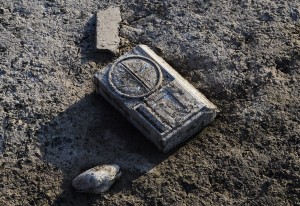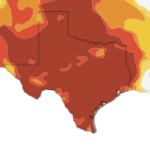West Texas Seeing ‘Driest Such Period in Over a Century’

EPA/LARRY W. SMITH /LANDOV
An old radio lies in the mud exposed after the water has gone at Lake Arrowhead State Park near Wichita Falls, Texas, in September 2013
Conditions ‘Remain Dire,’ Outlook Says
The drought that began in October 2010 has been the driest such period in over a century for much of West Texas, putting it on par with the drought of record in the 1950s. That’s according to a new outlook from the National Oceanic and Atmospheric Administration (NOAA), and it could get worse before it gets better.
While the drought over the last four years has caused billions in agricultural losses and strained the water supplies of smaller communities (some of them even running out), it is only now that the situation is getting to a similar point for some larger towns and cities. The city of Wichita Falls, in North Texas, will enter ‘catastrophic’ Stage 5 water restrictions tomorrow, their highest level. That will ban all outdoor watering or irrigation of golf courses from city water; car washes will be restricted to operating five days a week and only at certain times to reduce evaporation. The combined level of the city’s reservoirs has fallen below 25 percent.
The city is weeks away from the deployment of a temporary direct wastewater recycling program, the first of its kind in the country, that could keep supplies more stable as summer approaches. It would provide 5 million gallons of water a day to Wichita Falls, or about one-third of the city’s daily demand. A longer-term indirect reuse program is in the works which will provide up to three times that amount, nearly all the water the city needs each day, but it will take years to permit and build.
In Central Texas, the main reservoirs for Austin and surrounding cities down to 36 percent and falling. They could reach their lowest levels in history this summer. Just a few months ago, under ten percent of Texas was in the worst stages of drought. Today, 40 percent of Texas is in “extreme to exceptional drought.”
Some key takeaways from the outlook:
- More agricultural losses are expected: “Over 2/3 of the winter wheat crop in Texas and Oklahoma is in poor to very poor condition,” the report says.
- “Statewide, Texas reservoirs at lowest levels since 1990” for this time of year. Texas’ surface reservoirs are currently only 65 percent full.
- More than 70 percent of Texas is in drought conditions.
- Over the next three months, higher-than-normal temperatures are likely across the state. “Increased evaporation of any rain that does fall is likely with higher temperatures … further exacerbating surface reservoir water deficits,” the report says.
Now for the reassuring part: June tends to be the wettest month for Texas (followed in a close second by May), so “even near-normal rainfall should bring some short-term drought relief,” the report says.
And the odds of an El Niño weather pattern appearing this fall, which could bring more relief, have increased. There’s now a nearly 80 percent of El Nino showing up, which “would have limited drought impacts through the summer but likely drought relief in the fall/winter” for Texas, according to NOAA.
Other forecasters aren’t so sure. Chris Coleman, meteorologist at the Electric Reliability Council of Texas (ERCOT), which manages the Texas grid, took the wind out of a lot of drought-watchers sails recently when he said a forthcoming El Niño might not bring the relief we hope.
“In fact, of the past six [El Niños], only one brought above-normal rainfall to the majority of the state,” Coleman wrote in his forecast. “Some El Niño events have been dry.” That’s how two of the past six El Niño events in Texas turned out, where conditions were “predominantly dry,” including the sizable El Niño of 1997-1998, Coleman said at the time.
In the near-term, “it’s one of those things where it will probably get worse before it gets better,” says Brian Hoeth, a meteorologist with the National Weather Service that worked on the report. “From I-35 westward, we have a really, really bad situation as far as the reservoirs are concerned. There’s some of the lowest readings we’ve seen since we’ve been taking records.”

